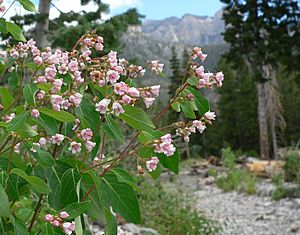Fly-trap dogbane facts for kids
Quick facts for kids Spreading dogbane |
|
|---|---|
 |
|
| Apocynum androsaemifolium var. androsaemifolium growing in the Spring Mountains, southern Nevada. | |
| Scientific classification | |
| Genus: |
Apocynum
|
| Species: |
androsaemifolium
|
| Synonyms | |
|
|
Apocynum androsaemifolium, often called the fly-trap dogbane or spreading dogbane, is a type of flowering plant. It belongs to a group of plants called Gentianales.
This plant is very common in North America. You can find it across most of the United States and Canada, and also in Alaska, California, and parts of northeast Mexico.
Contents
About the Spreading Dogbane Plant
The spreading dogbane plant has stems that branch out. The underside of its leaves has small hairs, but the stems themselves are smooth. If a stem breaks, a milky sap comes out.
Its leaves are shaped like pointed ovals. The edges of the leaves are smooth. Its flowers grow at the end of a stalk.
The plant contains natural substances that can be harmful. Because of this, it is important not to touch or eat any part of the plant.
Different Types of Spreading Dogbane
There are several different types, or varieties, of spreading dogbane. These varieties can be found in various regions across North America. For example, some types grow in eastern Canada and the western United States. Other varieties are found in places like British Columbia, Washington State, and even parts of Mexico.
How People Used Spreading Dogbane
Native Americans used the spreading dogbane plant in many ways. They used it as a medicine to help with different health problems. This included headaches, earaches, and even heart issues.
For example, the Ojibwe people used the root to help with headaches. They also used it for throat problems. The Forest Potawatomi and Prairie Potawatomi also used the roots and fruits for medicine.
The stems of the spreading dogbane plant have very strong fibers. Native Americans used these fibers like thread for sewing. In Europe, people also used spreading dogbane to help with heart problems in the early 1900s.
See also
 In Spanish: Apocynum androsaemifolium para niños
In Spanish: Apocynum androsaemifolium para niños

